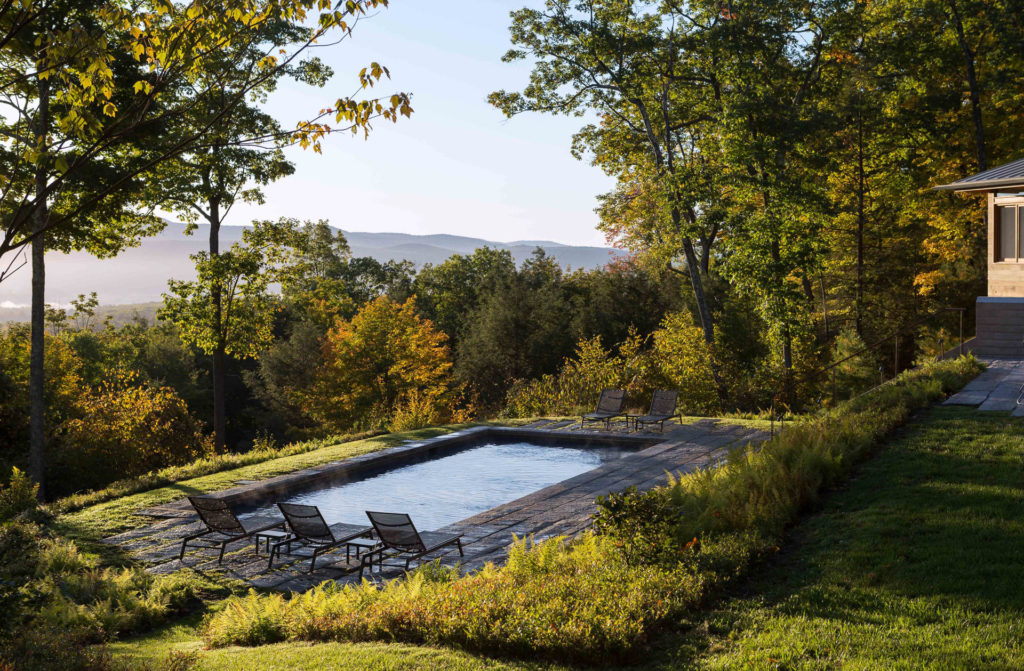BERKSHIRE RESIDENCE
GREAT BARRINGTON, MASSACHUSETTS
With the arrival of the railroad in the late 19th century, the Berkshires region quickly developed as a popular summer community for those seeking relief from the heat and pollution of industrialized Boston and New York. Great Barrington is equidistant between the two cities, drawing wealthy urban families with means to build elaborate homes and compounds throughout the rugged mountainous region. Today, a thriving arts and music scene draws enlightened crowds who appreciate the agricultural communities that dot the surrounding landscape. As the region’s popularity has grown and new homes have encroached on the very resources that have drawn people in, strict scenic preservation and watershed management regulations have begun to shape development in an effort to alleviate environmental pressures felt throughout the Berkshires.
This project navigates strict watershed protection requirements guided by the local Conservation Commission and adheres to rigorous regulations defined by the Scenic Mountain Act. The SMAct requires all existing mature canopy trees to be permanently registered and protected throughout all phases of construction. No work is permitted within these tree’s critical root zones. In addition to the spatial limitations posed by an inability to remove trees, strict stormwater management rules guided creative rain garden solutions to mediate roof and hardscape drainage. These spatial parameters drove design strategies for the whole team and required excellent communication and collaboration.
The clients, accomplished professionals with an appreciation for art and architecture, desired a year-round home that appeared surgically inserted into the surrounding existing woodland context. Three primary project goals quickly took shape: 1) to successfully navigate and adhere to strict scenic and water quality protection requirements; 2) to blur lines between indoor and outdoor spaces; and 3) to authentically blend the modern architectural forms with the rugged mountain setting.
A spectacular dream home and native woodland garden nestles seamlessly into a heavily-wooded, east-facing slope overlooking mesmerizing, multi-seasonal views of the Berkshires. Two contemporary buildings, a main home and guest cabin, conceived of and built several years apart, blend into the surrounding mountain context. The year-round retreat provides endless opportunities for an active family with pets to connect with nature and to leave the stresses of urban living behind.
Board-formed concrete retaining walls combined with crisply-graded, vegetated slopes, result in dramatic terraces that merge interior and exterior spaces property-wide. The project limits present more than 30-vertical-feet of elevation change over a very modest horizontal distance before blending into the existing adjacent >2:1 slopes. Intensive project programming required thoughtful spatial consideration, and the placement of a circular loop drive, multiple walls and terraces, a swimming pool, and activity lawns had to be carefully positioned within the aforementioned design parameters.
The resulting landscape presents multiple unique outdoor spaces to observe the dazzling mountainous woodland atmosphere. Both the upper main terrace and lower swimming pool areas respond to relationships established by interior elevations of the home. The new landscape presents a calm and authentic woodland aesthetic that allows the modern architectural forms to stand prominently on the site. Salvaged slabs of weathered granite curbing become an artistic and durable new hardscape vernacular, as exquisite masonry improvements complement the building’s complex geometries. A stepping stone path links the guest cabin to all of the main house’s inviting amenities. The linear paving patterns integrate porous joints to help convey rainwater. Custom steel and river stone drywells are positioned to efficiently collect and distribute stormwater from complex rooflines and gutter systems. Thoughtfully placed drains and retention trenches slow water velocities and direct roof-water into new bio-retention basins. The vegetated depressions are placed at the lowest areas of disturbance where slow-release spillways channel cleansed water into the adjacent undisturbed woodland. The basins are effectively invisible from prominent outdoor spaces.
A new gravel entry loop driveway provides a well-integrated entry and arrival sequence for the homeowners. Intensive excavation efforts on the west side of the house revealed dense bedrock just inches below the existing grades. Due to steep topographic conditions and thin soil depths, only a shallow layer of soil could be installed in many areas of the property. Erosion control was of major importance, and an unwavering palette of indigenous native sods were used to revegetate and stabilize new landforms. The new planting colonies prevent soil erosion and safeguard water quality within the sensitive watershed, all while presenting a dramatic and authentic display of multi-seasonal color year-round. In short, the project goals are surpassed, and the mountainside retreat is firmly rooted into its surrounding context.
Collaborators: Mathison | Mathison Architects, The Small Building Company, Okerstrom Lang Landscape Architects, Berkshire Engineering Inc., C&J Katz Studio, Monterey Masonry, Ingersoll Land Care; Photography by: Chuck Choi Photography and Matthew Cunningham













































































